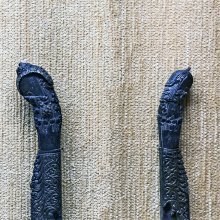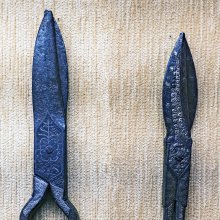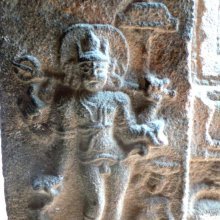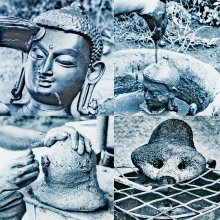Cutting: 4 definitions
Introduction:
Cutting means something in Hinduism, Sanskrit, the history of ancient India. If you want to know the exact meaning, history, etymology or English translation of this term then check out the descriptions on this page. Add your comment or reference to a book if you want to contribute to this summary article.
Images (photo gallery)
In Hinduism
Purana and Itihasa (epic history)
Source: Shodhganga: Elements of Art and Architecture in the Trtiyakhanda of the VisnudharmottarapuranaCutting (of different designs) on Bhurjapatra (for decorating the forehead) refers to one of the “sixty four kinds of Art”, according to the Kamasutra of Vatsyayana.—Cf. the Sanskrit Viśeṣakacchedya.—Indian tradition, basically includes sixty four Art forms are acknowledged. The history of Indian Art covers approximately five thousand years which presents a rich and almost continuous record. The references of sixty four kinds of Kala (कला, kalā) are found in the Bhagavatapurana, Shaiva-Tantras, Kamasutra of Vatsyayana etc.

The Purana (पुराण, purāṇas) refers to Sanskrit literature preserving ancient India’s vast cultural history, including historical legends, religious ceremonies, various arts and sciences. The eighteen mahapuranas total over 400,000 shlokas (metrical couplets) and date to at least several centuries BCE.
Natyashastra (theatrics and dramaturgy)
Source: Shodhganga: Elements of Art and Architecture in the Trtiyakhanda of the Visnudharmottarapurana (natya)1) Cutting is associated with Kartarīmukha-hasta: one of the twenty-two Single-hand Gestures (in Indian Dramas) (known as asaṃyuktahastas), according to the Viṣṇudharmottarapurāṇa, an ancient Sanskrit text which (being encyclopedic in nature) deals with a variety of cultural topics such as arts, architecture, music, grammar and astronomy.—The word kartarī means scissor and along with the word mukha, it means mouth of the scissor. [...] Some activities like traveling, cutting and falling are projected with this hand gesture.
2) Cutting (with powerful weapon) is also associated with Mṛgaśīrṣa-hasta: another one of the twenty-two Single-hand Gestures.—The word mṛgaśīrṣa is the union of two words viz., mṛga and śīrṣa. The word mṛga means deer and śīrṣa means head. So, it can be said that the hand posture which is called mṛgaśīrṣa identifies a posture that looks like the head of a deer. [...] The mṛgaśīrṣa-hasta posture is used to denote piercing, cutting, and moving upward of the powerful weapon.

Natyashastra (नाट्यशास्त्र, nāṭyaśāstra) refers to both the ancient Indian tradition (shastra) of performing arts, (natya—theatrics, drama, dance, music), as well as the name of a Sanskrit work dealing with these subjects. It also teaches the rules for composing Dramatic plays (nataka), construction and performance of Theater, and Poetic works (kavya).
Vastushastra (architecture)
Source: Shodhganga: Elements of Art and Architecture in the Trtiyakhanda of the Visnudharmottarapurana (vastu)The Cutting of Trees was carefully done by architects for the purpose of gathering Material for the Construction of Temples, according to the Viṣṇudharmottarapurāṇa, an ancient Sanskrit text which (being encyclopedic in nature) deals with a variety of cultural topics such as arts, architecture, music, grammar and astronomy.—In the Viṣṇudharmottarapurāṇa, the architect is suggested to go to the forest to collect appropriate wood for temples in an auspicious day after taking advice from an astrologer. [...] The trees growing in a śmaśāna, temple, ant hill, road or which is the only tree of a garden should not be cut for making temples and they should be left with care. Moreover, the Viṣṇudharmottarapurāṇa gives importance in saving the useable trees and that is why the trees viz., Palāsa, Kovidāra, Śālmalī, Pippala, Vaṭa, Āmra, Puṣpaka, Kapittha, Vibhītaka, Vetasa etc. are advised not to be cut as these trees and their fruits are very essential for livelihood.
At the time of Cutting the Trees one should clean the axe by smearing honey and ghee. After collecting the suitable wood from forest, the architect uses it according to his requirements and purposes. The eco-friendly suggestions of Viṣṇudharmottarapurāṇa are seen to protect the greenery and to balance a pollution free environment.

Vastushastra (वास्तुशास्त्र, vāstuśāstra) refers to the ancient Indian science (shastra) of architecture (vastu), dealing with topics such architecture, sculpture, town-building, fort building and various other constructions. Vastu also deals with the philosophy of the architectural relation with the cosmic universe.
India history and geography
Source: Singhi Jain Series: Ratnaprabha-suri’s Kuvalayamala-katha (history)Cutting (of gold) was a process used by the Goldsmith in ancient India to remove impurities in Gold, according to “A Cultural note on the Kuvalayamala of Uddyotanasuri” by the late Dr. V. s. Agrawala.—There is a reference to gold of highest purity. Whatever impurity or dross was contained in the gold brought to the goldsmith was removed by the latter by subjecting it to different processes of testing it on the touch-stone, cutting (cheda), heating under regulated fire, beating out into flat sheets, filing the sheets and the same process of beating it into a different shape, giving it a shape of round bar and dividing into several parts for final testing.

The history of India traces the identification of countries, villages, towns and other regions of India, as well as mythology, zoology, royal dynasties, rulers, tribes, local festivities and traditions and regional languages. Ancient India enjoyed religious freedom and encourages the path of Dharma, a concept common to Buddhism, Hinduism, and Jainism.
See also (Relevant definitions)
Starts with: Cutting grass.
Ends with: Stencil cutting.
Full-text (+1226): Chedana, Cheda, Viccheda, Krintana, Accheda, Uccheda, Chida, Kartana, Chatachuta, Vicchitti, Nikrintana, Chedi, Vrashcana, Vardhapana, Avaccheda, Ucchedana, Katarakutara, Shatana, Lava, Abhilava.
Relevant text
Search found 271 books and stories containing Cutting; (plurals include: Cuttings). You can also click to the full overview containing English textual excerpts. Below are direct links for the most relevant articles:
Bharadvaja-srauta-sutra (by C. G. Kashikar)
Vinaya Pitaka (1): Bhikkhu-vibhanga (the analysis of Monks’ rules) (by I. B. Horner)
Satapatha-brahmana (by Julius Eggeling)
Kāṇḍa I, adhyāya 7, brāhmaṇa 2 < [First Kāṇḍa]
Kāṇḍa II, adhyāya 5, brāhmaṇa 3 < [Second Kāṇḍa]
Kāṇḍa V, adhyāya 1, brāhmaṇa 3 < [Fifth Kāṇḍa]
Manusmriti with the Commentary of Medhatithi (by Ganganatha Jha)
Verse 5.6 < [Section II - Objectionable Food]
Verse 11.142 < [Section XVI - Expiation for cutting Trees and other Offences]
Verse 11.104 < [Section X - Expiation for the violating of the Preceptor’s Bed (gurutalpa)]
Vinaya Pitaka (4): Parivara (by I. B. Horner)
As To Graduation (6. Sextets) < [7. As To Graduation]
As To Graduation (5. Pentads) < [7. As To Graduation]
Indian Medicinal Plants (by Kanhoba Ranchoddas Kirtikar)
52. Podophyllum emodi, Wall. < [Berberidaceae (barberry family)]
Notes on rasanjana (aqueous extract of Berberis aristata) < [Notes]
Introduction, part 1: History of the study of medicinal plants
Related products








